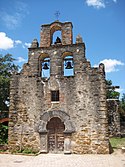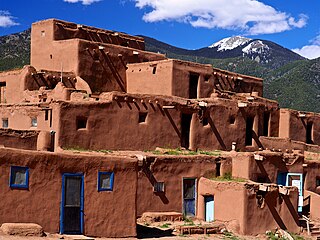
Taos Pueblo is an ancient pueblo belonging to a Taos-speaking (Tiwa) Native American tribe of Puebloan people. It lies about 1 mile (1.6 km) north of the modern city of Taos, New Mexico. The pueblos are one of the oldest continuously inhabited communities in the United States. This has been designated a UNESCO World Heritage Site.
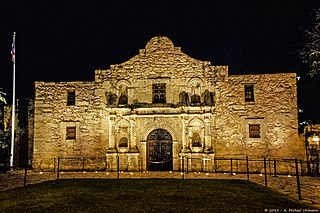
San Antonio, officially the City of San Antonio, is a city in and the county seat of Bexar County, Texas, United States. The city is the seventh-most populous in the United States, the second-largest in the Southern United States, and the second-most populous in Texas after Houston. It is the 12th-most populous city in North America, with 1,434,625 residents as of 2020.
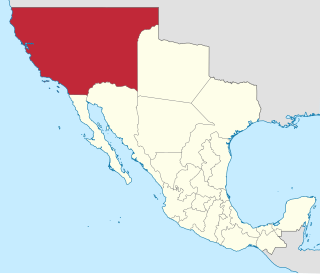
Alta California, also known as Nueva California among other names, was a province of New Spain formally established in 1804. Along with the Baja California peninsula, it had previously comprised the province of Las Californias, but was made a separate province in 1804. Following the Mexican War of Independence, it became a territory of Mexico in April 1822 and was renamed Alta California in 1824.

The Alamo is a historic Spanish mission and fortress compound founded in the 18th century by Roman Catholic missionaries in what is now San Antonio, Texas, United States. It was the site of the Battle of the Alamo in 1836, a pivotal event of the Texas Revolution in which American folk heroes James Bowie and Davy Crockett died. Today it is a museum in the Alamo Plaza Historic District and a part of the San Antonio Missions World Heritage Site.

Tejanos are the residents of the state of Texas who are culturally descended from the Mexican population of Tejas and Coahuila that lived in the region prior to it becoming what is now known as the state of Texas before it became a U.S. state in 1845. The term is also sometimes applied to all Texans of Mexican descent.

Tourism in Mexico is a very important industry. Since the 1960s, it has been heavily promoted by the Mexican government, as "an industry without smokestacks." Mexico has traditionally been among the most visited countries in the world according to the World Tourism Organization, and it is the second-most visited country in the Americas, after the United States. In 2017, Mexico was ranked as the sixth-most visited country in the world for tourism activities. Mexico has a significant number of UNESCO World Heritage Sites, with the list including ancient ruins, colonial cities, and natural reserves, as well as a number of works of modern public and private architecture. Mexico has attracted foreign visitors beginning in the early nineteenth century, with its cultural festivals, colonial cities, nature reserves and the beach resorts. The nation's temperate climate and unique culture – a fusion of the European and the Mesoamerican – are attractive to tourists. The peak tourism seasons in the country are during December and the mid-Summer, with brief surges during the week before Easter and Spring break, when many of the beach resort sites become popular destinations for college students from the United States.

An empresario was a person who had been granted the right to settle on land in exchange for recruiting and taking responsibility for settling the eastern areas of Coahuila y Tejas in the early nineteenth century. The word in Spanish for entrepreneur is emprendedor.

San Antonio Missions National Historical Park is a National Historical Park and part of a UNESCO World Heritage Site preserving four of the five Spanish frontier missions in San Antonio, Texas, USA. These outposts were established by Catholic religious orders to spread Christianity among the local natives. These missions formed part of a colonization system that stretched across the Spanish Southwest in the 17th, 18th, and 19th centuries.
Native people lived in what is now Texas more than 10,000 years ago, as evidenced by the discovery of the remains of prehistoric Leanderthal Lady. In 1519, the arrival of the first Spanish conquistadors in the region of North America now known as Texas found the region occupied by numerous Native American tribes. The name Texas derives from táyshaʼ, a word in the Caddoan language of the Hasinai, which means "friends" or "allies." In the recorded history of what is now the U.S. state of Texas, all or parts of Texas have been claimed by six countries: France, Spain, Mexico, the Republic of Texas, the Confederacy during the Civil War, and the United States of America.

The Spanish Missions in Texas comprise a series of religious outposts established by Spanish Catholic Dominicans, Jesuits, and Franciscans to spread the Catholic doctrine among area Native Americans, but with the added benefit of giving Spain a toehold in the frontier land. The missions introduced European livestock, fruits, vegetables, and industry into the Texas area. In addition to the presidio and pueblo (town), the misión was one of the three major agencies employed by the Spanish crown to extend its borders and consolidate its colonial territories. In all, twenty-six missions were maintained for different lengths of time within the future boundaries of the state of Texas.

Spanish Colonial architecture represents Spanish colonial influence on New World and East Indies' cities and towns, and it is still seen in the architecture as well as in the city planning aspects of conserved present-day cities. These two visible aspects of the city are connected and complementary. The 16th-century Laws of the Indies included provisions for the layout of new colonial settlements in the Americas and elsewhere.

Beginning in the 16th century Spain established missions throughout New Spain in order to facilitate colonization of these lands.

The San Antonio River is a major waterway that originates in central Texas in a cluster of springs in midtown San Antonio, about 4 miles north of downtown, and follows a roughly southeastern path through the state. It eventually feeds into the Guadalupe River about 10 miles from San Antonio Bay on the Gulf of Mexico. The river is 240 miles long and crosses five counties: Bexar, Goliad, Karnes, Refugio, and Wilson.

The Camino Real de Tierra Adentro, also known as the Silver Route, was a Spanish 2,560-kilometre-long (1,590 mi) road between Mexico City and San Juan Pueblo, New Mexico, that was used from 1598 to 1882. It was the northernmost of the four major "royal roads" that linked Mexico City to its major tributaries during and after the Spanish colonial era.
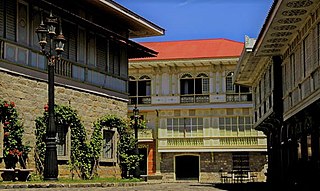
The architecture of the Philippines reflects the historical and cultural traditions in the country. Most prominent historic structures in the archipelago are influenced by Austronesian, Chinese, Spanish, and American architectures.

The National Park System is well endowed to commemorate Hispanic contributions to American society. Some 20 national parklands represent Hispanic heritage in the United States. Some sites remotely display Hispanic contributions to American culture. The National Park System not only preserves the history and contributions of Hispanic Americans, it is also a part of the nation's history. Over the years, the National Park Service has reflected the nation's social history. Among the first Hispanics who influenced the course of the National Parks were:

The City of San Antonio is one of the oldest Spanish settlements in Texas and was, for decades, its largest city. Before Spanish colonization, the site was occupied for thousands of years by varying cultures of indigenous peoples. The historic Payaya Indians were likely those who encountered the first Europeans.

The Spanish missions in the Americas were Catholic missions established by the Spanish Empire during the 16th to 19th centuries in the period of the Spanish colonization of the Americas. Many hundreds of missions, durable and ephemeral, created by numerous Catholic religious orders were scattered throughout the entirety of the Spanish colonies, which extended southward from the United States and Mexico to Argentina and Chile.

The Coahuiltecan were various small, autonomous bands of Native Americans who inhabited the Rio Grande valley in what is now northeastern Mexico and southern Texas. The various Coahuiltecan groups were hunter-gatherers. First encountered by Europeans in the 16th century, their population declined due to European diseases, slavery, and numerous small-scale wars fought against the Spanish, criollo, Apache, and other Indigenous groups.
Canarian Americans are Americans whose ancestors came from the Canary Islands, Spain. They can trace their ancestry to settlers and immigrants who have emigrated since the 16th century to the present-day United States. Most of them are descendants of settlers who immigrated to Spanish colonies in the South of the modern US during the 18th century. The Canarians were among the first settlers of the modern United States; the first Canarians migrated to modern Florida in 1569, and were followed by others coming to La Florida, Texas and Louisiana.
